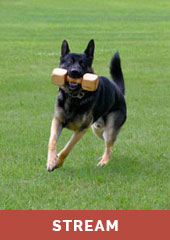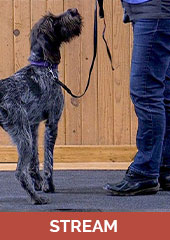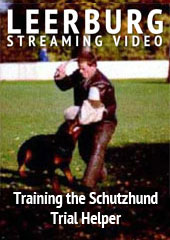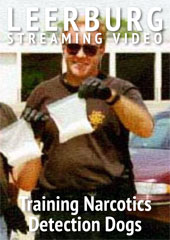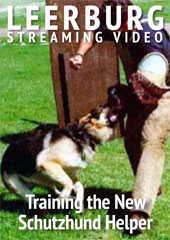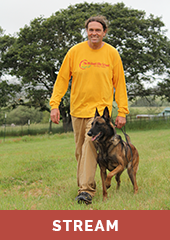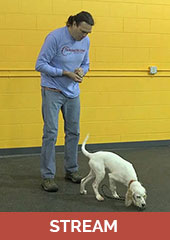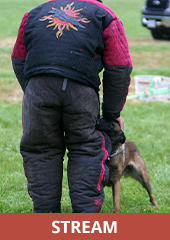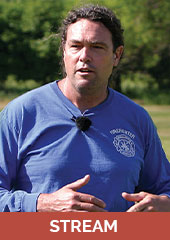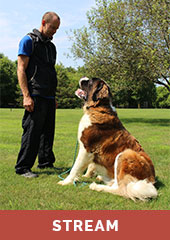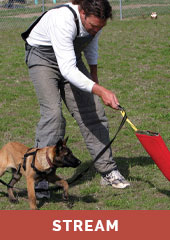3 hr, 17 min
October 13, 2011
This is the latest in Leerburg's series of training videos done with Michael Ellis.
It's a training video that follows Michael's curriculum for his course on Motivation and Play at his school for dog trainers in California: michaelellisschool.com
The work in this DVD (or video on demand) teaches trainers of all breeds (large and small) and trainers from every dog sport (agility, obedience, and protection sports) the advanced concepts of how to motivate their dogs.
The goal of this training is to teach dog trainers how to turn a reward into an event for their dog. When trainers can learn these skills they are going to be able to manipulate the motivation and drive of their dogs.
The chapters for this training video are:
-Learning Moving Skills Without a Dog
-Rewards Are An "Interactive"
-Techniques for Increasing Motivation
-Borrowing Techniques From the World of Protection Sports - Not All biting is Protection
-How to Manage Your Dog's Genetics
-Establishing Rules
In our chapter on Learning Moving Skills Without a Dog, Michael introduces trainers to movement skills they can learn without their dog to help develop and increase a dog's motivation and drive. In this chapter trainers will learn:
-Backing drills
-Lateral drills
-Line/luring drills
-Weight shift/balance drills
-How to use your legs and not your back
-Tug/toy presentation without a dog
-Food handling without a dog - how to hold and deliver
-Why straight line targeting - the problem with hooking
-Getting bit is bad for the handler and dogs motivation
-Misses - How and Why?
In the chapter titled Rewards Are an "Interactive Event" trainers will learn:
-Movement is reinforcing during a reward
-Contrasts between a "reward event" vs. "normal behavior"
-The differences between "hunger drive" and movement-based "prey rewards"
-Variable duration of the "reward event" and its effect on post-reinforcement pause/attention
-Using auditory stimulators to stimulate motivation
-Chasing and searching are better than having
-Tugging, Chasing, and Eating
In the chapter for Techniques for Increasing Motivation Michael covers:
-Using restraint and frustration to build motivation
-Learning to balance and use HUNGER and a tool
-How "social isolation" can be a tool to increase motivation
-Patterning arousal levels/classical conditioning
-What activities intensify through rehearsal, which don't
-Restricting and channeling your dogs' energy use
-Appropriate toys and treats
-Violating your dog's expectations. Using food and toys in the same training session.
-Balancing possession without creating conflict
In the chapter, Borrowing Techniques From the World of Protection Sports, we explain the following:
-Restrain/frustration revisited
-Using back pressure to build motivation
-Building the "STRIKE" as a factor of motivation
-Revisiting Targeting
-Revisiting the Auditory Stimulator
-Letting the dog "WIN"
The chapter on How to Manage Your Dog's Genetics will cover:
-"PLAYERS" vs. "FIGHTERS"
-Spatial awareness and sensitivity
-Possessiveness - the pros and cons, learning to initiate
-Internal vs. External dogs and how to motivate each
In the chapter, Establishing Rules, we cover:
-When to add rules without causing confict
-How strict should you be?
-Capping drives
-The balance between motivation and rules
Video on Demand
Instant access for a lifetime
Get huge savings on the DVD (view details)
Stream from anywhere around the world
Easy to jump to chapters
Add bookmarks/notes while you watch
Need help? Check our FAQ.
Advanced Concepts in Motivation Turning Your Reward into an Event with Michael Ellis
Uploaded on October 13, 2011 •
3 hr, 17 min
This is the latest in Leerburg's series of training videos done with Michael Ellis.
It's a training video that follows Michael's curriculum for his course on Motivation and Play at his school for dog trainers in California: michaelellisschool.com
The work in this DVD (or video on demand) teaches trainers of all breeds (large and small) and trainers from every dog sport (agility, obedience, and protection sports) the advanced concepts of how to motivate their dogs.
The goal of this training is to teach dog trainers how to turn a reward into an event for their dog. When trainers can learn these skills they are going to be able to manipulate the motivation and drive of their dogs.
The chapters for this training video are:
-Learning Moving Skills Without a Dog
-Rewards Are An "Interactive"
-Techniques for Increasing Motivation
-Borrowing Techniques From the World of Protection Sports - Not All biting is Protection
-How to Manage Your Dog's Genetics
-Establishing Rules
In our chapter on Learning Moving Skills Without a Dog, Michael introduces trainers to movement skills they can learn without their dog to help develop and increase a dog's motivation and drive. In this chapter trainers will learn:
-Backing drills
-Lateral drills
-Line/luring drills
-Weight shift/balance drills
-How to use your legs and not your back
-Tug/toy presentation without a dog
-Food handling without a dog - how to hold and deliver
-Why straight line targeting - the problem with hooking
-Getting bit is bad for the handler and dogs motivation
-Misses - How and Why?
In the chapter titled Rewards Are an "Interactive Event" trainers will learn:
-Movement is reinforcing during a reward
-Contrasts between a "reward event" vs. "normal behavior"
-The differences between "hunger drive" and movement-based "prey rewards"
-Variable duration of the "reward event" and its effect on post-reinforcement pause/attention
-Using auditory stimulators to stimulate motivation
-Chasing and searching are better than having
-Tugging, Chasing, and Eating
In the chapter for Techniques for Increasing Motivation Michael covers:
-Using restraint and frustration to build motivation
-Learning to balance and use HUNGER and a tool
-How "social isolation" can be a tool to increase motivation
-Patterning arousal levels/classical conditioning
-What activities intensify through rehearsal, which don't
-Restricting and channeling your dogs' energy use
-Appropriate toys and treats
-Violating your dog's expectations. Using food and toys in the same training session.
-Balancing possession without creating conflict
In the chapter, Borrowing Techniques From the World of Protection Sports, we explain the following:
-Restrain/frustration revisited
-Using back pressure to build motivation
-Building the "STRIKE" as a factor of motivation
-Revisiting Targeting
-Revisiting the Auditory Stimulator
-Letting the dog "WIN"
The chapter on How to Manage Your Dog's Genetics will cover:
-"PLAYERS" vs. "FIGHTERS"
-Spatial awareness and sensitivity
-Possessiveness - the pros and cons, learning to initiate
-Internal vs. External dogs and how to motivate each
In the chapter, Establishing Rules, we cover:
-When to add rules without causing confict
-How strict should you be?
-Capping drives
-The balance between motivation and rules
It's a training video that follows Michael's curriculum for his course on Motivation and Play at his school for dog trainers in California: michaelellisschool.com
The work in this DVD (or video on demand) teaches trainers of all breeds (large and small) and trainers from every dog sport (agility, obedience, and protection sports) the advanced concepts of how to motivate their dogs.
The goal of this training is to teach dog trainers how to turn a reward into an event for their dog. When trainers can learn these skills they are going to be able to manipulate the motivation and drive of their dogs.
The chapters for this training video are:
-Learning Moving Skills Without a Dog
-Rewards Are An "Interactive"
-Techniques for Increasing Motivation
-Borrowing Techniques From the World of Protection Sports - Not All biting is Protection
-How to Manage Your Dog's Genetics
-Establishing Rules
In our chapter on Learning Moving Skills Without a Dog, Michael introduces trainers to movement skills they can learn without their dog to help develop and increase a dog's motivation and drive. In this chapter trainers will learn:
-Backing drills
-Lateral drills
-Line/luring drills
-Weight shift/balance drills
-How to use your legs and not your back
-Tug/toy presentation without a dog
-Food handling without a dog - how to hold and deliver
-Why straight line targeting - the problem with hooking
-Getting bit is bad for the handler and dogs motivation
-Misses - How and Why?
In the chapter titled Rewards Are an "Interactive Event" trainers will learn:
-Movement is reinforcing during a reward
-Contrasts between a "reward event" vs. "normal behavior"
-The differences between "hunger drive" and movement-based "prey rewards"
-Variable duration of the "reward event" and its effect on post-reinforcement pause/attention
-Using auditory stimulators to stimulate motivation
-Chasing and searching are better than having
-Tugging, Chasing, and Eating
In the chapter for Techniques for Increasing Motivation Michael covers:
-Using restraint and frustration to build motivation
-Learning to balance and use HUNGER and a tool
-How "social isolation" can be a tool to increase motivation
-Patterning arousal levels/classical conditioning
-What activities intensify through rehearsal, which don't
-Restricting and channeling your dogs' energy use
-Appropriate toys and treats
-Violating your dog's expectations. Using food and toys in the same training session.
-Balancing possession without creating conflict
In the chapter, Borrowing Techniques From the World of Protection Sports, we explain the following:
-Restrain/frustration revisited
-Using back pressure to build motivation
-Building the "STRIKE" as a factor of motivation
-Revisiting Targeting
-Revisiting the Auditory Stimulator
-Letting the dog "WIN"
The chapter on How to Manage Your Dog's Genetics will cover:
-"PLAYERS" vs. "FIGHTERS"
-Spatial awareness and sensitivity
-Possessiveness - the pros and cons, learning to initiate
-Internal vs. External dogs and how to motivate each
In the chapter, Establishing Rules, we cover:
-When to add rules without causing confict
-How strict should you be?
-Capping drives
-The balance between motivation and rules
Comments
Mafk9
February 12, 2024
Nice beginning video to teach you the trainer the basics movement needed to move smoothly with your dog
Igauthier
April 18, 2023
Exactly what I was looking for
fmrubio
January 1, 2021
Because this video covers a lot of the questions I had after watching the power of training with food and the power of playing tug videos, I would recommend that every person buy this video along with the other two videos. I waited to get this video because I thought I had a good understanding. This video answers the most important questions I had regarding why my dog wasn’t as engaged during play as I wanted him to be and why my dog was so possessive.
Dorkwin
December 17, 2019
Michael hints in his opening remarks that he will advise how to deal with a dog that is possessive of the tug but does not. My dog drives into the tug, plays with energy and outs well but he will not return the toy. Can anyone here help? Or can anyone from Leerburg suggest a video that covers this issue?
lokimar1017
August 1, 2019
Very informative great material
maellison
June 12, 2019
This video has lots of great information. However, you cannot easily advance or backup the video if you want to replay something or advance. Most videos this day and age have fast and slow forward and back. The audio is also quite weak and the streaming frequently stops and then has to restart. I find Ed Frawley to be patronizing and his comments in the video are a serious detraction. Michael is great Ed not so much. So a great video that is marred by production issues and the inclusion of someone other then Michael doing narrative.
fi12ebird
July 12, 2018
Such a simple and obvious topic, yet I would never have thought about it. This content is the true definition of a world class trainer. You won't find this kind of stuff on YouTube or anywhere else and for me and my Malinois it has fostered an amazing relationship.
dld22
January 27, 2018
Content is great, but the video keeps skipping - certain parts will repeat a few seconds 2-3 times. I don’t think it is my internet connection because the time elapsed is moving forward throughout the skips. Makes it tough to watch.
Adokikennels
January 8, 2018
Another wonderdul dvd that I believe, that everyone should have. This will be one that I will be returning to often!
HughIV
August 4, 2017
Out of the 15 plus videos I've purchased from Leerburg this one is at the top! "Making rewards interactive" has changed my training and my 1 year old dog is exploding with energy during our training sessions.
Highly recommended!
Highly recommended!
BRoza00
December 15, 2016
I put off watching this video and I highly regret it. This video IS the best Michael Ellis video of all time. Even if you are familiar with Michael's techniques, you will learn A LOT from this video. Michael is a certified dog training guru and his ideas of dog training is just brilliant. I'm sure a lot of us have met these heavy handed, negative trainers, and we all want to steer clear of those guys. What Michael teaches is positive, fun, and rewarding to a dog. Instead of a tail tucked, ears back, lip lickin' dog, you get an attentive, ready-to-work machine!
I'd rate this DVD 10 stars out of 5 if I could.
I'd rate this DVD 10 stars out of 5 if I could.
Jade04022016
December 5, 2016
After watching power of training with food, tug, and focused heeling multiple times I would recommend this DVD before any of them. It provides information on how to motivate your dog to the level they need to learn as well as teach the handler the techniques to enhance the experience. My 8 month old Dutch shepherd has learned greatly from this video.
MelBlacke
April 3, 2016
Another great video: I really like how he emphasizes what YOU are supposed to be doing and his explanations for why are specific. if I manage to incorporate these specific techniques into my skill set as a trainer--it will help me improve tremendously.
Farzad
March 1, 2016
This video is without a doubt one of the best, if not the best, in the entire series. I have had the privilege of studying most of Michael's videos in the series, and I can tell you that this video is really the glue that binds everything. All of the components of Michael's system work on their own, but when supplemented with these motivational techniques they produce amazing results.
There is a 40 minute section on footwork and movement without the dog that is delivered with such detail, care, and enthusiasm that truly inspires you stop the video and start doing the drills on your own.
I was initially a bit doubtful about purchasing this video, but now, I can say with certainty that all of what I've learned from the other videos became twice as much efficient and fun after studying this DVD.
Can't wait for more from Michael and company!
There is a 40 minute section on footwork and movement without the dog that is delivered with such detail, care, and enthusiasm that truly inspires you stop the video and start doing the drills on your own.
I was initially a bit doubtful about purchasing this video, but now, I can say with certainty that all of what I've learned from the other videos became twice as much efficient and fun after studying this DVD.
Can't wait for more from Michael and company!
newpoodlemom
September 4, 2015
This is just what I need. Motivation training is something that needs to be taught and to the handler does not come naturally. I love how Michael Ellis breaks this into small areas to discuss and makes it easier to help the dog enjoy training.
PawsU
August 14, 2015
Michael could be a dancer!
Thank you for the motivation to do even better for my clients...
I was told to find a mentor -I think I have found him
Thank you for the motivation to do even better for my clients...
I was told to find a mentor -I think I have found him
kingsj
April 11, 2012
This is an outstanding overview of Michael Ellis's view of dog drives and motivation, and how to interact with a dog to encourage useful tendencies while avoiding unuseful tendencies. I own most of the other ME video's (all outstanding), and I felt this one explained in more detail the "why?" for many of his techniques. I found this video very helpful and feel I have a deeper understanding of how to use the ME system to optimize my own dogs training.
I felt this video was a stong peice of ME training system and strengthened my overall understanding of these training methods.
I felt this video was a stong peice of ME training system and strengthened my overall understanding of these training methods.

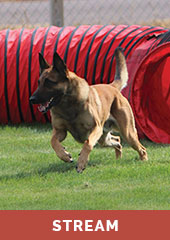
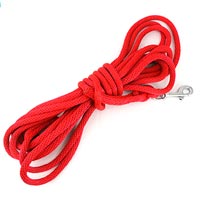

.jpg)


